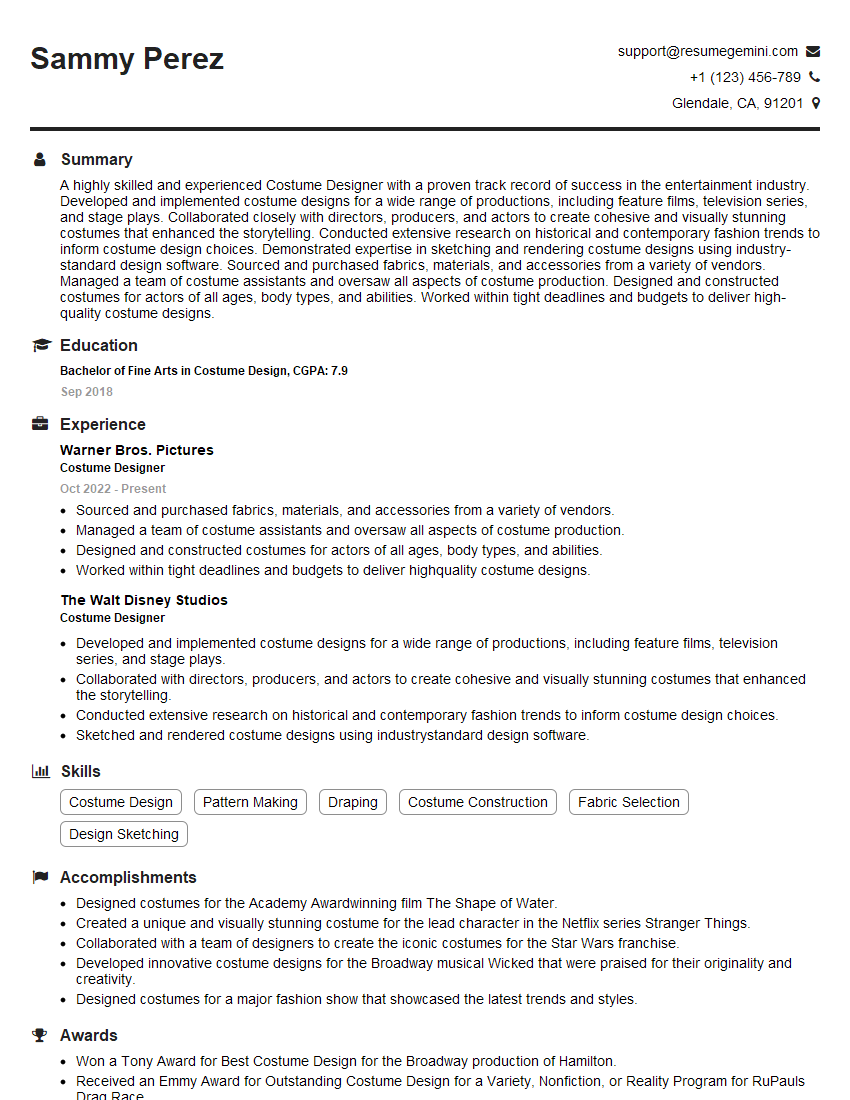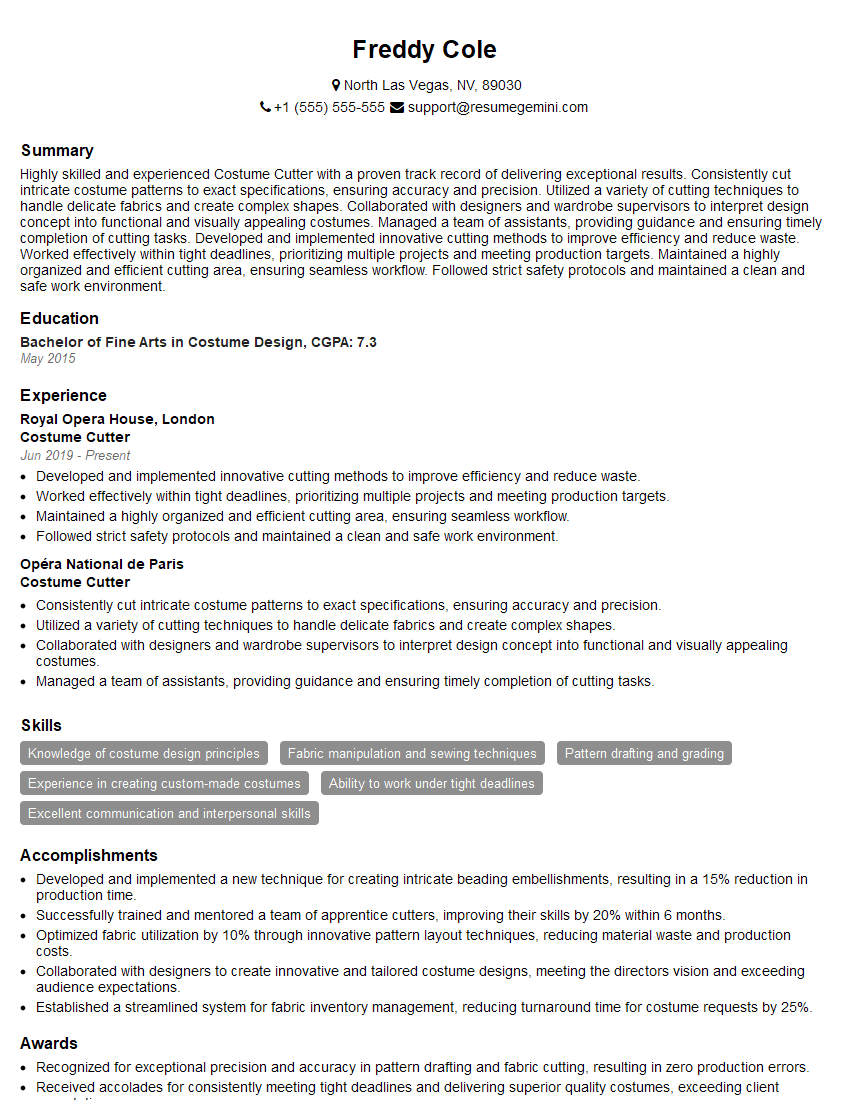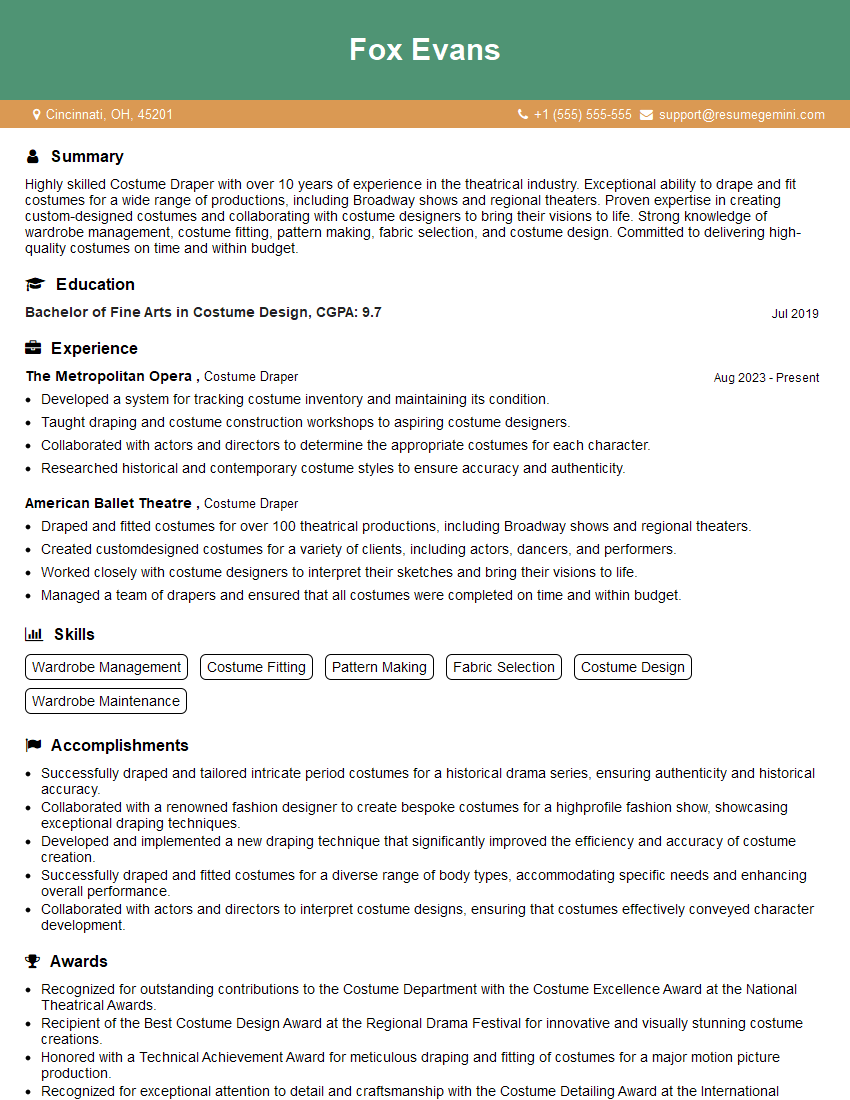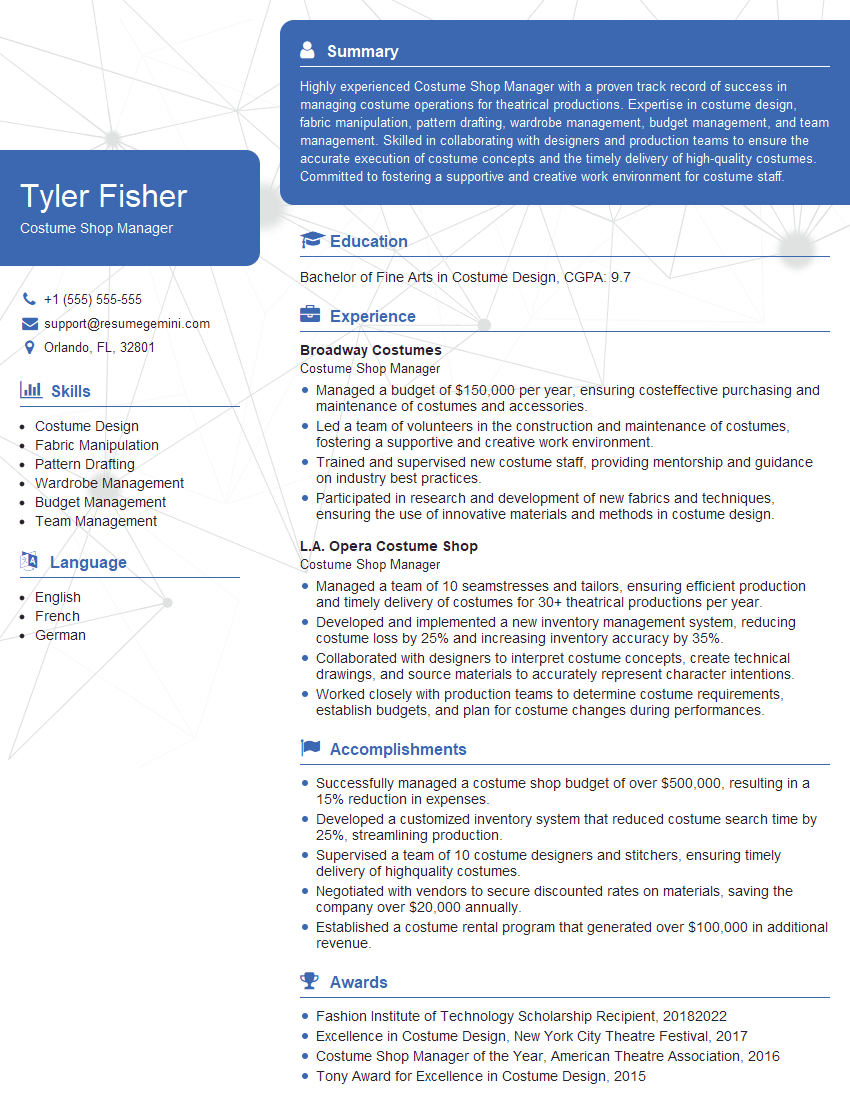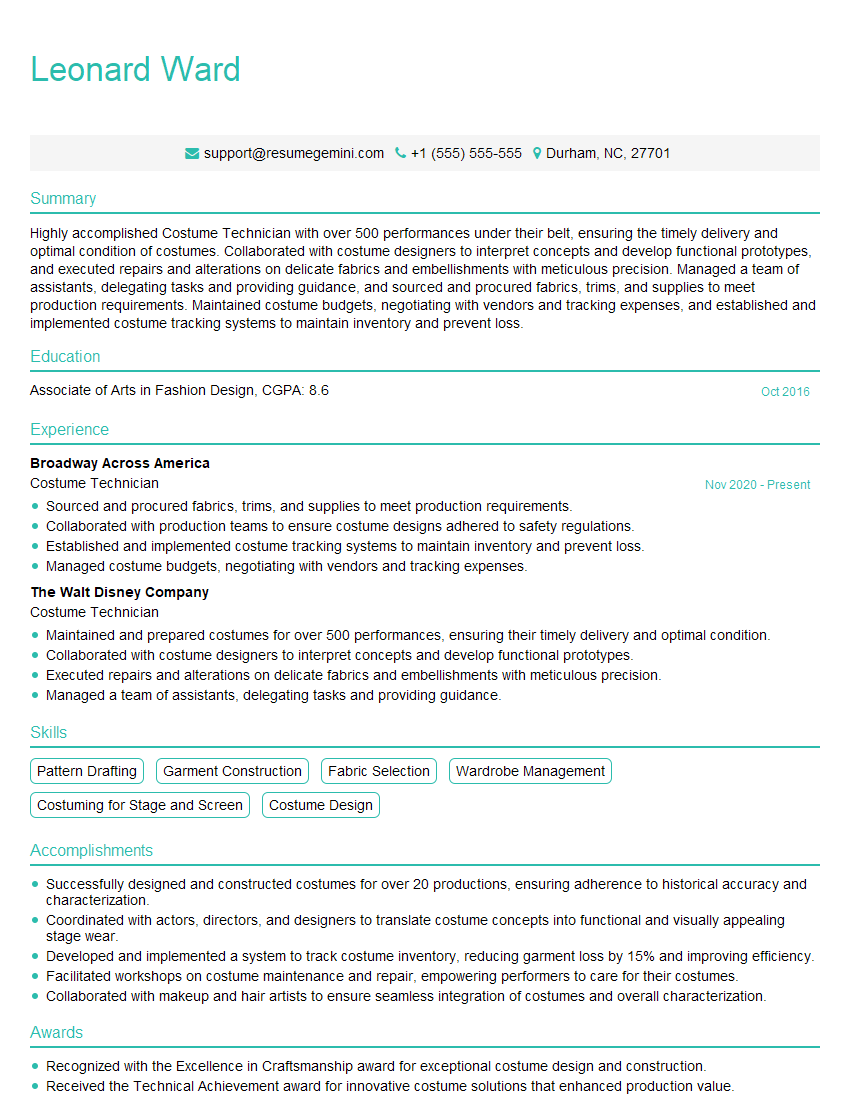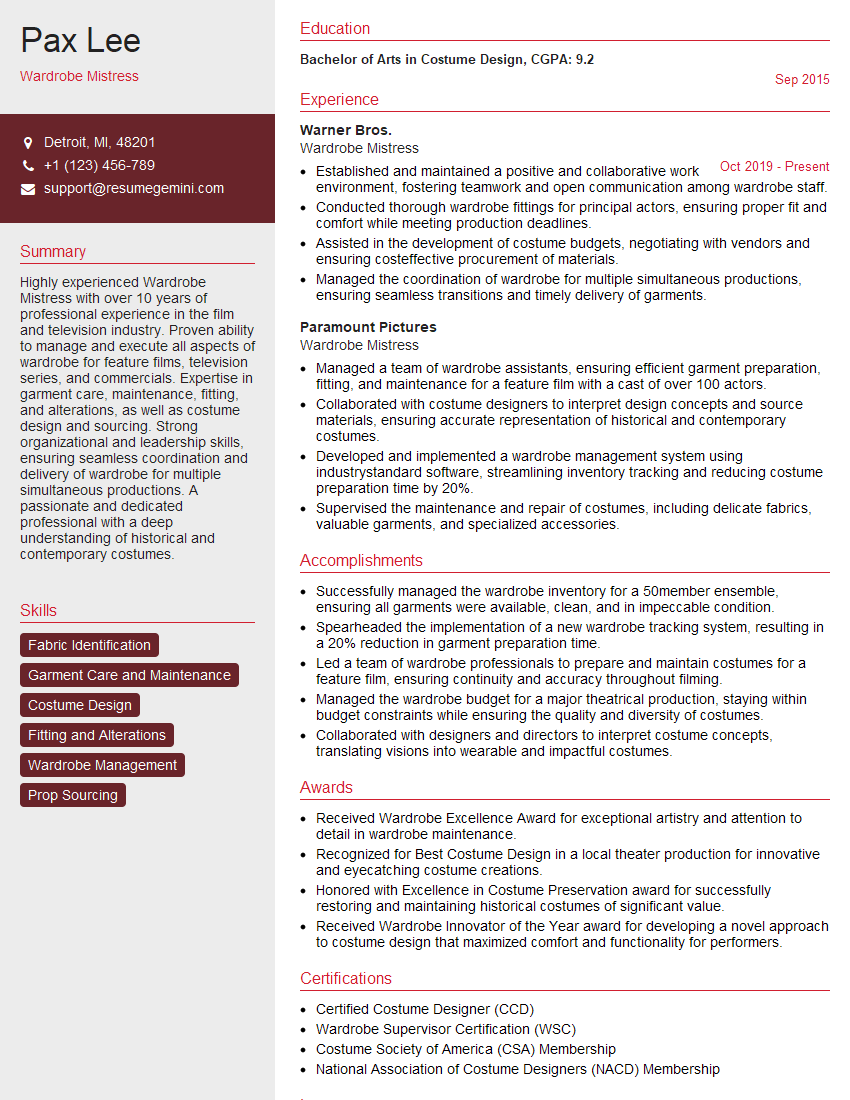Cracking a skill-specific interview, like one for Costume Literacy, requires understanding the nuances of the role. In this blog, we present the questions you’re most likely to encounter, along with insights into how to answer them effectively. Let’s ensure you’re ready to make a strong impression.
Questions Asked in Costume Literacy Interview
Q 1. Describe the differences between historical and contemporary costume construction techniques.
Historical and contemporary costume construction techniques differ significantly, primarily due to advancements in technology and the evolution of fashion sensibilities. Historically, garments were often constructed by hand using time-consuming techniques, emphasizing durability and functionality. Think of the intricate hand-stitching found in 18th-century stays or the painstaking process of creating elaborate embroidery on medieval garments. Natural fibers like linen, wool, and silk were predominantly used, with limited access to dyes resulting in a more muted palette. Contemporary construction, conversely, often utilizes industrial machines like sewing machines and sergers, enabling faster production and more complex designs. Synthetic fabrics, offering varied textures, colors, and properties, have expanded the creative possibilities. While hand-sewing remains a valuable skill, it’s frequently combined with machine sewing to achieve optimal results. For example, a historical costume might incorporate hand-stitched details to achieve authenticity, while the garment’s base construction might be machine-sewn for efficiency. The contrast is clear: a historically accurate gown might take weeks to create entirely by hand, whereas a similar-looking contemporary design, incorporating machine sewing, might take significantly less time.
Q 2. Explain the importance of accurate historical research in costume design.
Accurate historical research is paramount in costume design; it forms the foundation of authenticity and believability. Without it, a costume risks being anachronistic or inaccurate, detracting from the overall production. My research involves studying period paintings, photographs, surviving garments, and written sources like diaries, letters, and pattern books to understand not only the garment’s silhouette but also its construction techniques, materials, and even the social context in which it was worn. For example, designing a Victorian-era gown requires understanding the use of crinolines or bustles, the type of fabrics popular during that period (e.g., silk, wool, and cotton), and the social significance of color and embellishment. A seemingly small detail like the type of buttons or the placement of seams can reveal significant historical information. Without this rigorous process, the costume risks becoming a mere imitation instead of a faithful representation of a particular time and place. I once worked on a period drama set in the French Revolution; painstaking research ensured that each costume reflected the social standing of the character accurately, from the fabrics to the embellishments. The result was a more immersive and believable experience for the audience.
Q 3. How do you determine the appropriate fabric choices for a specific character or period?
Fabric choice is crucial for conveying character and period accuracy. My selection process begins with research into the period and the character’s social status. For instance, a wealthy noblewoman in the 17th century would likely wear luxurious silks and velvets, while a peasant would wear more durable, less expensive fabrics like linen or wool. The climate also plays a role—lightweight cottons are suitable for summer, while heavier wools are better for winter. Texture is another critical element; the rough texture of a burlap sackcloth contrasts sharply with the smooth drape of a silk brocade, highlighting differences in social class or personality. Furthermore, the availability of certain fabrics during specific periods must be considered; using a synthetic fiber that didn’t exist historically is a major error. The color is equally important, as social and cultural codes dictated appropriate hues. Finally, I consider the practical aspects, like the fabric’s drapability, its suitability for specific techniques, and how it might react to lighting. For example, a richly colored velvet might look stunning but prove challenging to light on stage.
Q 4. What are the key factors to consider when creating a costume budget?
Creating a costume budget requires a meticulous approach. It begins with a detailed breakdown of all anticipated expenses, including materials (fabric, thread, findings, etc.), labor (my own time and potentially the cost of assistants), rentals (if any), alterations, and shipping. I carefully estimate the quantity and cost of each material, considering potential waste and unforeseen issues. Labor costs are crucial; I factor in my hourly rate and the number of hours expected for design, pattern-making, construction, fitting, and alterations. Contingency funds are vital to account for unexpected costs such as material shortages or the need for alterations. When working on large-scale productions, I create a spreadsheet to track each costume’s budget individually, ensuring transparency and allowing for efficient resource allocation. This detailed budget is then presented to the production team for approval, ensuring there’s clear understanding of the financial commitment involved. I’ve found that thorough budgeting not only avoids financial overruns but also helps in making informed decisions regarding material choices and construction techniques.
Q 5. Describe your process for adapting a costume design from a sketch to a finished garment.
Adapting a costume design from a sketch to a finished garment is a multi-step process. It starts with creating a detailed pattern, often using a combination of drafting techniques and fitting adjustments on a muslin (inexpensive fabric) to ensure a proper fit. The pattern is then transferred to the chosen fabric, paying close attention to grainlines and pattern placement for optimal drape and appearance. The individual pieces are meticulously cut and assembled, incorporating relevant construction techniques like seams, darts, and closures. Multiple fittings are crucial throughout the process to ensure a perfect fit and to make necessary adjustments. The final stages involve finishing details such as hems, facings, and embellishments. I always keep detailed notes throughout this process—a record of measurements, fitting adjustments, and any special techniques used. This documentation is crucial for future reference and for reproducing similar designs. For example, when creating a complex Elizabethan ruff, I’d document each step of the construction, including the pattern pieces, the starching process, and the method of assembly. This detailed record aids reproducibility and reduces time-consuming experimentation.
Q 6. How do you manage multiple costume projects simultaneously?
Managing multiple costume projects simultaneously requires excellent organizational skills and time management strategies. I use project management software to track each project’s progress, deadlines, and associated tasks. I prioritize tasks based on deadlines and their dependency on one another. For instance, I might focus on completing all the pattern making for multiple projects before moving on to fabric cutting and construction. Furthermore, I create detailed checklists for each project to keep track of individual components and materials. Color-coding or tagging systems help to visually separate different projects in my workspace. Regular review sessions are also crucial to ensure I’m on schedule and to identify and address any potential roadblocks early on. Delegation, when possible, can significantly improve efficiency. A clear communication strategy is also essential; I maintain close communication with the production team, keeping them updated on the progress of each project and proactively addressing any concerns.
Q 7. Explain your experience with various costume construction methods (e.g., hand-sewing, machine sewing, draping).
My experience encompasses a wide range of costume construction methods. Hand-sewing remains an essential skill, especially for intricate details and period-accurate techniques. I’m proficient in various hand stitches, from basic running stitches to more complex techniques like French seams and blind hems. Machine sewing is invaluable for efficiency, particularly on large projects, and I’m adept at using different sewing machines for varied tasks. Draping is a crucial skill for creating unique and sculptural garments. I’m able to create patterns directly on the dress form using fabric, which allows for greater flexibility and experimentation. Other techniques in my repertoire include smocking, embroidery, beading, and various types of appliqué work. My skills are adapted to the demands of each project. A historical reproduction might demand extensive hand-sewing, while a modern-day design might rely more heavily on machine sewing and draping. The combination of these skills allows for a versatile approach to costume creation, ensuring I can execute designs accurately and efficiently regardless of their style or period.
Q 8. How do you collaborate effectively with other members of the production team (e.g., director, actors, designers)?
Effective collaboration is the cornerstone of successful costume design. It’s a continuous dialogue, not a one-way street. With the director, I start by deeply understanding their vision for the piece – the overall aesthetic, the character arcs, and the intended emotional impact. This often involves reviewing the script and discussing character sketches. With the actors, I prioritize fittings that are comfortable and collaborative, ensuring the costumes allow for ease of movement and expression. Open communication about comfort, fit, and any practical concerns is vital. Finally, with other designers (set, lighting, etc.), I ensure the costumes complement, rather than clash with, the overall production design. We discuss color palettes, textures, and the overall visual harmony to create a cohesive and stunning theatrical experience.
For example, on a recent Shakespeare production, the director wanted to emphasize the timeless quality of the piece, while the actors needed costumes that would allow them to move freely during the sword fights. By working closely with the director and actors, and understanding the set designer’s vision of a minimalistic stage, I created costumes that were both historically inspired and functionally appropriate.
Q 9. How do you troubleshoot problems during a costume fitting or performance?
Troubleshooting during fittings or performances requires quick thinking and a resourceful approach. Problems can range from a ripped seam to an uncomfortable accessory. My first step is always to assess the problem calmly and systematically. A ripped seam during a performance, for instance, requires a quick, backstage repair. I keep a well-stocked kit with needles, thread, safety pins, and fabric glue. For a more significant issue like an ill-fitting piece, I might need to make minor alterations on the spot, perhaps by adjusting seams or using temporary solutions until a permanent fix can be implemented. Communication is key; updating the actors and director on the situation ensures everyone is informed and coordinated in finding a resolution.
For example, during a musical’s dress rehearsal, one actor’s costume was too tight, restricting his vocal ability. Quickly assessing the situation, I used seam rippers to carefully release some stitching in the back and sides, alleviating the pressure without visibly altering the costume. We then replaced the tight-fitting corset with a lighter layer for the performance.
Q 10. Describe your experience working with different textile types and their properties.
My experience with textiles is extensive, spanning various types and their unique properties. I understand the drape, weight, texture, and durability of fabrics like silks, velvets, linens, wools, cottons, and synthetics. This knowledge influences my design choices significantly. Silk, for instance, offers luxurious drape but requires delicate handling. Wool is warm and durable, ideal for period pieces, but can be prone to shrinkage. Understanding these characteristics allows me to choose the most appropriate fabric for each character and situation. I’m also familiar with textile treatments like dyeing, printing, and embellishment techniques.
In a recent historical drama, I selected heavy brocade for regal characters, emphasizing their status and opulence. For the more working-class characters, I opted for durable linen and cotton fabrics that better reflected their lives. Knowing the specific properties of each material ensured the costumes were historically accurate and appropriate for their roles.
Q 11. Explain your knowledge of different pattern-cutting techniques.
My pattern-cutting skills encompass various techniques, including drafting from scratch, draping on a dress form, and modifying existing patterns. I’m proficient in flat pattern making, using both commercial and custom patterns. I can adjust patterns to accommodate different body types and design requirements. Understanding the grainlines, darts, seams, and ease is essential for a well-fitting garment. I regularly employ techniques like French seams and flat-felled seams for durability and a clean finish. My understanding extends to different pattern weights, influencing the design’s final form and structure.
For example, in creating a Victorian gown, I started with a basic bodice pattern and then adapted it by adding boning channels and adjusting the shaping for a period-accurate silhouette. This involved careful manipulation of darts and seams to achieve the desired form.
Q 12. How do you ensure the safety and comfort of actors in their costumes?
Actor safety and comfort are paramount. During the design phase, I prioritize fabrics that are breathable and comfortable, especially for lengthy performances. I avoid materials that might cause irritation or allergies. I also consider practical aspects like ease of movement, ensuring the costumes don’t impede an actor’s ability to perform their role. Safety features, like securely fastened accessories, reinforced seams, and fire-retardant treatments (where necessary) are incorporated throughout the process. Regular fittings allow for adjustments and address any concerns the actors may have.
For instance, I once created a costume with a long train for a period piece. The actor was concerned about tripping, so I added a small, hidden hook system allowing her to attach the train at the waist during active scenes, ensuring both safety and visual impact.
Q 13. What are your strategies for sourcing materials and maintaining cost-effectiveness?
Sourcing materials cost-effectively requires a multifaceted approach. I begin by thoroughly researching different suppliers, comparing prices and qualities. This involves sourcing from both local fabric stores and online vendors. I look for end-of-season sales and utilize fabric scraps creatively to minimize waste and costs. I often explore alternative materials, such as repurposing vintage clothing or using less expensive fabrics strategically combined with more luxurious accents. Careful planning and accurate estimations are essential to avoiding unnecessary expenses.
For example, in a recent low-budget production, I repurposed vintage fabrics for some of the costumes, sourcing others during end-of-season sales. This allowed me to create historically accurate costumes without exceeding the budget.
Q 14. Describe your experience working with special effects makeup or prosthetics related to costume.
While my primary expertise lies in costume design and construction, I have experience collaborating with special effects makeup artists and prosthetics designers. This collaboration is crucial for creating seamless integrations between costumes and special effects elements. I understand the technical aspects of applying prosthetics and the materials needed, ensuring the costumes are compatible and supportive of the makeup. Communication with the makeup artist is key to ensure a cohesive and believable overall look.
For a recent fantasy production, I worked closely with the special effects team to create a costume that seamlessly incorporated prosthetic horns. We discussed the weight and placement of the prosthetics to ensure the costume provided support and comfort while maintaining its integrity throughout the performance.
Q 15. How familiar are you with different eras of costume design (e.g., Elizabethan, Victorian, Art Deco)?
My familiarity with different eras of costume design is extensive. I possess a deep understanding of the historical context, silhouette, fabrics, and construction techniques specific to various periods. For instance, the Elizabethan era (1558-1603) is characterized by its opulent use of rich fabrics like velvet and brocade, structured bodices, and the iconic ruff. The Victorian era (1837-1901) saw a dramatic shift, with a focus on corsetry, full skirts (think crinolines and bustles), and a wider range of silhouettes depending on the decade. Art Deco (1920s-1930s), in contrast, emphasized geometric shapes, sleek lines, bias-cut dresses, and the use of luxurious materials like sequins and beading. I can readily discuss the nuances of each era, including regional variations and the social implications of clothing choices.
Understanding these distinctions allows me to create historically accurate or historically-inspired costumes that are both visually appealing and thematically appropriate. For example, if designing for a production of Shakespeare, I’d ensure the costumes reflect the opulence and social hierarchy depicted in the play through careful fabric selection, embellishment, and overall silhouette. Likewise, a 1920s flapper dress would be instantly recognizable by its characteristic drop waist, fringed hem, and overall sense of freedom and modernity.
Career Expert Tips:
- Ace those interviews! Prepare effectively by reviewing the Top 50 Most Common Interview Questions on ResumeGemini.
- Navigate your job search with confidence! Explore a wide range of Career Tips on ResumeGemini. Learn about common challenges and recommendations to overcome them.
- Craft the perfect resume! Master the Art of Resume Writing with ResumeGemini’s guide. Showcase your unique qualifications and achievements effectively.
- Don’t miss out on holiday savings! Build your dream resume with ResumeGemini’s ATS optimized templates.
Q 16. What software programs are you proficient in for costume design and drafting?
I am proficient in several software programs crucial for costume design and drafting. My expertise includes:
- Adobe Photoshop: For manipulating images, creating digital prints, and designing textures.
- Adobe Illustrator: For creating precise vector illustrations, patterns, and technical drawings.
- Clo3D: A 3D virtual fashion design software allowing for realistic garment draping and simulations before physical construction.
- Pattern design software (e.g., Optitex): For creating and modifying patterns for various garments and sizes.
Proficiency in these programs allows me to create detailed technical packets including pattern pieces, fabric specifications, and construction notes, enhancing collaboration with the rest of the costume team and ensuring consistent results.
Q 17. How do you maintain accurate records of costumes throughout a production?
Maintaining accurate costume records is paramount for efficient production and potential future use. My system involves a multi-faceted approach:
- Detailed Inventory Database: I use a digital database (often spreadsheet-based) to track each costume’s individual components (fabric, trims, etc.), construction details, and assigned actor. This database includes images and measurements.
- Costume Plots: I create comprehensive costume plots that visually represent each character’s costumes throughout the production, including quick reference images and notes on any changes or alterations.
- Physical Labeling: Every costume piece receives clear and durable labels indicating its specific production, character, and piece identification. This ensures easy organization and identification throughout the production process and during storage.
- Photographs and Documentation: Detailed photographs are taken at each stage of the process: from initial design sketches to the final finished garment. This provides a visual record of the costume’s evolution and aids in troubleshooting and future reference.
This system ensures a smooth production workflow, streamlines the fitting process and simplifies the storage and retrieval of costumes for future use.
Q 18. What is your approach to altering and adapting existing garments for costumes?
Altering and adapting existing garments is a cost-effective and environmentally conscious practice. My approach is methodical and involves several steps:
- Assessment: I carefully assess the garment’s suitability for alteration, considering fabric type, construction, and overall condition.
- Design Adaptation: I sketch modifications, ensuring the changes align with the character’s needs and the production’s aesthetic.
- Pattern Adjustment: Where necessary, I adjust the existing pattern to accommodate the alterations, adding or removing seams, or changing the silhouette.
- Construction: I execute the alterations meticulously, using appropriate techniques for the specific fabric and construction.
- Fitting and Refinement: Multiple fittings are crucial to ensure a perfect fit and flawless execution of the design.
For example, I recently transformed a vintage 1950s dress into a character’s costume by adjusting the neckline, adding sleeves, and altering the waistline to create a completely unique design. This approach allows for creative problem-solving and resourcefulness.
Q 19. Describe a challenging costume project and how you overcame the obstacles.
A particularly challenging project involved creating costumes for a production of ‘Macbeth’ set in a dystopian future. The challenge lay in blending the historical context of the play with a futuristic aesthetic. Initially, I struggled with finding a cohesive visual language that honored both periods.
To overcome this, I employed a multi-step approach:
- Research: Extensive research into both Shakespearean fashion and dystopian design aesthetics, analyzing key elements from both styles.
- Concept Development: I created mood boards and sketches, experimenting with different ways to combine the two aesthetics. For instance, I explored incorporating elements of Elizabethan ruffs and collars into futuristic, technologically-inspired garments.
- Material Exploration: I experimented with various unconventional materials like repurposed metallic fabrics and incorporating LED lighting into the costumes to create a sense of futuristic technology.
- Collaboration: I collaborated closely with the set designer to ensure the costumes complemented the overall visual language of the production.
The final result was a unique and visually striking collection of costumes that successfully blended historical and futuristic elements, creating a cohesive and impactful visual representation of the play.
Q 20. Explain your understanding of different theatrical styles (e.g., realism, surrealism) and how they influence costume design.
Theatrical style significantly influences costume design. Realism, for example, demands accuracy and attention to detail, reflecting the period and social standing of the characters. Costumes in a realistic production would be accurate representations of the clothing of the era. Conversely, surrealism allows for a more imaginative and symbolic approach. Costumes might defy logic and reality, using unexpected materials and shapes to convey the play’s dreamlike or fantastical nature.
Consider the difference: a realistic portrayal of a 19th-century drawing-room would require historically accurate garments and accessories, while a surrealist interpretation of the same scene might feature distorted shapes, non-traditional fabrics, and symbolic elements. Understanding the director’s vision for the production is paramount in determining the appropriate level of realism or surrealism in the costumes.
Q 21. How do you interpret a character’s personality and motivations through their costume?
Interpreting a character’s personality and motivations through costume is central to my design process. I use several key strategies:
- Silhouette: The overall shape and lines of a costume can convey a character’s power, vulnerability, or social standing. A structured, sharp silhouette suggests power and control, while a flowing, relaxed silhouette might suggest gentleness or insecurity.
- Color Palette: Color choices communicate mood and personality. Bold colors can express confidence, while muted tones might suggest sadness or introversion.
- Fabric and Texture: The texture of a fabric can also reveal much about a character. Rough textures might suggest a character’s hard exterior, while soft textures could suggest tenderness or vulnerability.
- Accessories: Accessories like jewelry, hats, or weapons can enhance the character’s identity and convey specific information about their lifestyle and personality.
For instance, a character dressed in drab, ill-fitting clothes might immediately convey poverty and hardship, while a character in elaborate, flamboyant attire could be interpreted as self-assured and perhaps even arrogant. The details contribute to a compelling and nuanced portrayal.
Q 22. What is your approach to creating a costume that supports a character’s narrative?
Creating a costume that truly supports a character’s narrative goes beyond simply choosing visually appealing fabrics. It’s about translating the character’s inner world, their social standing, their journey, and their personality into a visual language. I start by deeply understanding the script and character profile. What is their background? What are their motivations? What is their emotional arc?
For example, if I’m designing for a character undergoing a transformation from rags to riches, their initial costume might be composed of dull, patched-up fabrics, perhaps slightly ill-fitting. As the character evolves, the costumes would reflect this change through richer fabrics, a better fit, and perhaps more elaborate details. Conversely, a character experiencing a downfall might see their initially elegant attire become more disheveled and worn over the course of the play.
My process involves sketching, fabric sourcing, and detailed construction. I consider silhouette, color palette, texture, and accessories to ensure every element speaks to the character’s narrative. It’s a careful balancing act of telling a story visually, subtly hinting at what the character may be hiding or revealing, all through their clothing.
Q 23. How do you address potential cultural sensitivities when designing costumes?
Cultural sensitivity is paramount in costume design. Appropriating cultural elements without understanding their significance is deeply disrespectful and can cause significant offense. My approach involves thorough research. I consult with cultural experts or community members when designing costumes that draw inspiration from specific cultures. I aim to understand the historical context and symbolism associated with particular garments, patterns, and accessories.
For instance, if I’m designing a costume that incorporates elements of Native American culture, I wouldn’t simply use random patterns or headdresses. I’d research the specific tribe, their traditional attire, and the significance of their designs, and collaborate with members of that community to ensure accurate and respectful representation. It’s not about imitation; it’s about understanding and honoring the cultural significance.
Avoiding stereotypes is crucial. I actively seek to portray cultural elements with nuance and avoid perpetuating harmful generalizations. Open communication and collaboration are key to ensuring responsible and respectful design choices.
Q 24. Explain your understanding of color theory and how it applies to costume design.
Color theory is the cornerstone of effective costume design. Understanding the psychology of color, its cultural associations, and its impact on mood and atmosphere is vital. I use the color wheel to create harmonious or contrasting palettes, depending on the desired effect. For example, warm colors like reds and oranges evoke energy and passion, while cool colors like blues and greens suggest calmness or serenity.
Complementary colors (those opposite each other on the wheel) create vibrant contrast, which can be impactful for highlighting a character or creating a dramatic effect. Analogous colors (those next to each other on the wheel) create a sense of harmony and unity, which might be suitable for a group scene or to emphasize a sense of belonging. Triadic colors (three colors evenly spaced on the wheel) provide a balanced yet dynamic palette.
Beyond basic color relationships, I also consider the saturation and value of colors. A highly saturated color grabs attention, while a muted tone can create a more subtle effect. I choose colors based on the character’s personality, the setting of the play, and the overall message the costume aims to convey. Consider a villain – perhaps dark, deep hues are used, while the hero may be dressed in brighter, more uplifting shades.
Q 25. Describe your experience with creating accessories and props that complement costumes.
Accessories and props are not mere additions to a costume; they are crucial elements that enhance the character’s narrative and visual appeal. My experience includes designing and sourcing a wide range of accessories, from intricate headpieces and jewelry to weapons and everyday objects. Each accessory undergoes the same careful consideration as the costume itself.
For example, I worked on a production of Hamlet where the character’s melancholic state was visually enhanced by a simple, yet effective, detail: a perpetually drooping, slightly tarnished silver locket. It added a layer of subtext without overpowering the overall costume. In another project, I designed a series of intricately carved wooden canes for a group of elderly characters, each reflecting their unique personalities through subtle variations in design.
In terms of props, I consider their functionality, durability, and historical accuracy. The creation of props involves researching materials, construction techniques, and potentially collaborating with prop makers to ensure authenticity and safety. The interplay between costume and props is crucial for creating a cohesive and believable world onstage.
Q 26. How do you manage alterations and repairs of costumes during a show’s run?
Managing alterations and repairs during a show’s run is a critical aspect of costume maintenance. I always build in a buffer for adjustments and unforeseen damages. This involves creating detailed patterns and keeping extra fabric on hand. A well-organized costume inventory with detailed records of each garment helps in tracking repairs and replacements.
During the run, I dedicate time each day or week, depending on the size of the production, for minor repairs. These can include mending seams, replacing buttons, or patching small tears. I also have a quick-fix kit backstage to handle minor emergencies during performances. For more substantial alterations, I have a designated time to make the necessary changes without disrupting the show’s schedule. Teamwork is essential; a strong rapport with the actors and the wardrobe crew is important to ensure that repairs are done swiftly and smoothly.
Documentation is crucial – I maintain a log of all repairs and alterations performed, including dates, descriptions, and the time spent on each task. This information is vital for future productions and for evaluating the durability of materials and construction techniques.
Q 27. What are your strategies for maintaining the integrity of costumes over time?
Maintaining the integrity of costumes over time requires a multifaceted approach that combines careful handling, appropriate storage, and regular maintenance. Quality materials are the foundation. Choosing durable fabrics and construction techniques that can withstand wear and tear is crucial. I always prioritize quality over quantity; a well-made costume will last longer than a cheaply made one.
Proper storage is essential. Costumes should be stored in clean, dry, and climate-controlled environments to prevent damage from moisture, pests, or extreme temperatures. Garments should be hung properly or folded carefully to avoid wrinkles or creases. I use acid-free tissue paper to protect delicate fabrics.
Regular cleaning and inspection are also critical. After each performance, costumes should be inspected for damage and cleaned according to the fabric’s care instructions. Dry cleaning may be necessary for some fabrics, while others may be hand-washed. Periodic professional cleaning is also beneficial to extend the lifespan of costumes. A well-maintained costume inventory, properly stored and meticulously documented, is crucial for the longevity and preservation of the costumes.
Q 28. Describe your experience with managing a costume inventory.
Managing a costume inventory is a critical skill. It requires a meticulous approach to organization, tracking, and maintenance. My system involves creating a comprehensive database for every item, including detailed descriptions, fabric types, sizes, and any unique characteristics. I use a digital inventory system – a spreadsheet or specialized software – that allows for efficient search and retrieval of information.
Each costume is assigned a unique identifier, and images are included for easy identification. This database also tracks the location of each costume (storage, being used in a show, under repair, etc.). The system includes a log of all alterations, repairs, and cleaning performed. This comprehensive tracking system makes it easy to locate costumes, identify items needing attention, and manage the overall health of the costume collection.
Regular audits are also essential to ensure the accuracy of the inventory and to identify any missing or damaged items. This meticulous record-keeping not only streamlines the process of accessing and managing costumes, but it’s crucial for insurance purposes and helps in planning future productions.
Key Topics to Learn for Your Costume Literacy Interview
- Historical Costume Evolution: Understanding the significant shifts in costume design across different eras and cultures. This includes recognizing key silhouettes, fabrics, and construction techniques.
- Fabric Identification and Properties: Knowing common fabrics used in costume construction (e.g., silk, wool, linen, cotton) and their characteristics (drape, texture, durability) is crucial for informed decision-making and accurate historical representation.
- Costume Design Principles: Grasping fundamental design concepts like silhouette, line, color, texture, and proportion, and how these elements contribute to character development and storytelling within a performance context.
- Construction Techniques and Pattern Making: Familiarity with basic sewing techniques, pattern drafting, and the process of creating a garment from initial design to finished product will demonstrate practical skills.
- Research and Sourcing: Understanding how to research historical periods and styles effectively, find appropriate source material (images, books, artifacts), and utilize this information to inform design choices.
- Character Analysis and Conceptualization: Demonstrate an ability to analyze a character’s personality, social status, and historical context to create an accurate and believable costume design.
- Budgeting and Resource Management: Explain how to approach costuming within budgetary constraints, manage resources effectively, and find creative solutions when faced with limitations.
- Collaboration and Communication: Discuss the importance of teamwork in a costume shop setting, effective communication with designers, directors, and other members of the production team.
Next Steps
Mastering Costume Literacy is paramount for career advancement in theatre, film, television, and other performance-based industries. A strong understanding of costume history, design principles, and practical skills sets you apart as a highly valuable asset. To further enhance your job prospects, create an ATS-friendly resume that showcases your skills and experience effectively. ResumeGemini is a trusted resource that can help you build a professional and impactful resume tailored to the Costume Literacy field. Examples of resumes specifically designed for Costume Literacy professionals are available to guide you. Invest the time to build a compelling resume; it’s your first impression on potential employers.
Explore more articles
Users Rating of Our Blogs
Share Your Experience
We value your feedback! Please rate our content and share your thoughts (optional).
What Readers Say About Our Blog
Hello,
We found issues with your domain’s email setup that may be sending your messages to spam or blocking them completely. InboxShield Mini shows you how to fix it in minutes — no tech skills required.
Scan your domain now for details: https://inboxshield-mini.com/
— Adam @ InboxShield Mini
Reply STOP to unsubscribe
Hi, are you owner of interviewgemini.com? What if I told you I could help you find extra time in your schedule, reconnect with leads you didn’t even realize you missed, and bring in more “I want to work with you” conversations, without increasing your ad spend or hiring a full-time employee?
All with a flexible, budget-friendly service that could easily pay for itself. Sounds good?
Would it be nice to jump on a quick 10-minute call so I can show you exactly how we make this work?
Best,
Hapei
Marketing Director
Hey, I know you’re the owner of interviewgemini.com. I’ll be quick.
Fundraising for your business is tough and time-consuming. We make it easier by guaranteeing two private investor meetings each month, for six months. No demos, no pitch events – just direct introductions to active investors matched to your startup.
If youR17;re raising, this could help you build real momentum. Want me to send more info?
Hi, I represent an SEO company that specialises in getting you AI citations and higher rankings on Google. I’d like to offer you a 100% free SEO audit for your website. Would you be interested?
Hi, I represent an SEO company that specialises in getting you AI citations and higher rankings on Google. I’d like to offer you a 100% free SEO audit for your website. Would you be interested?
good
